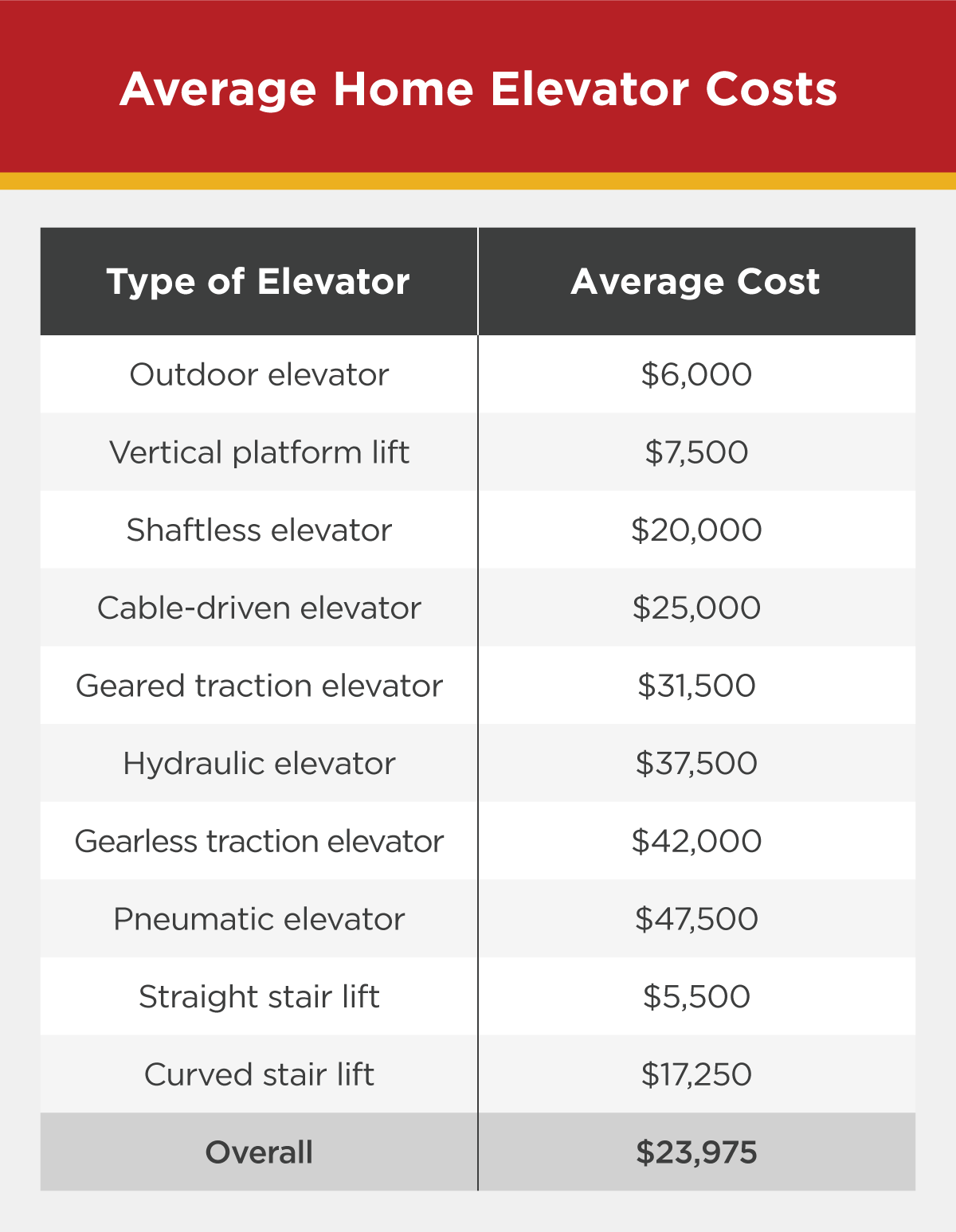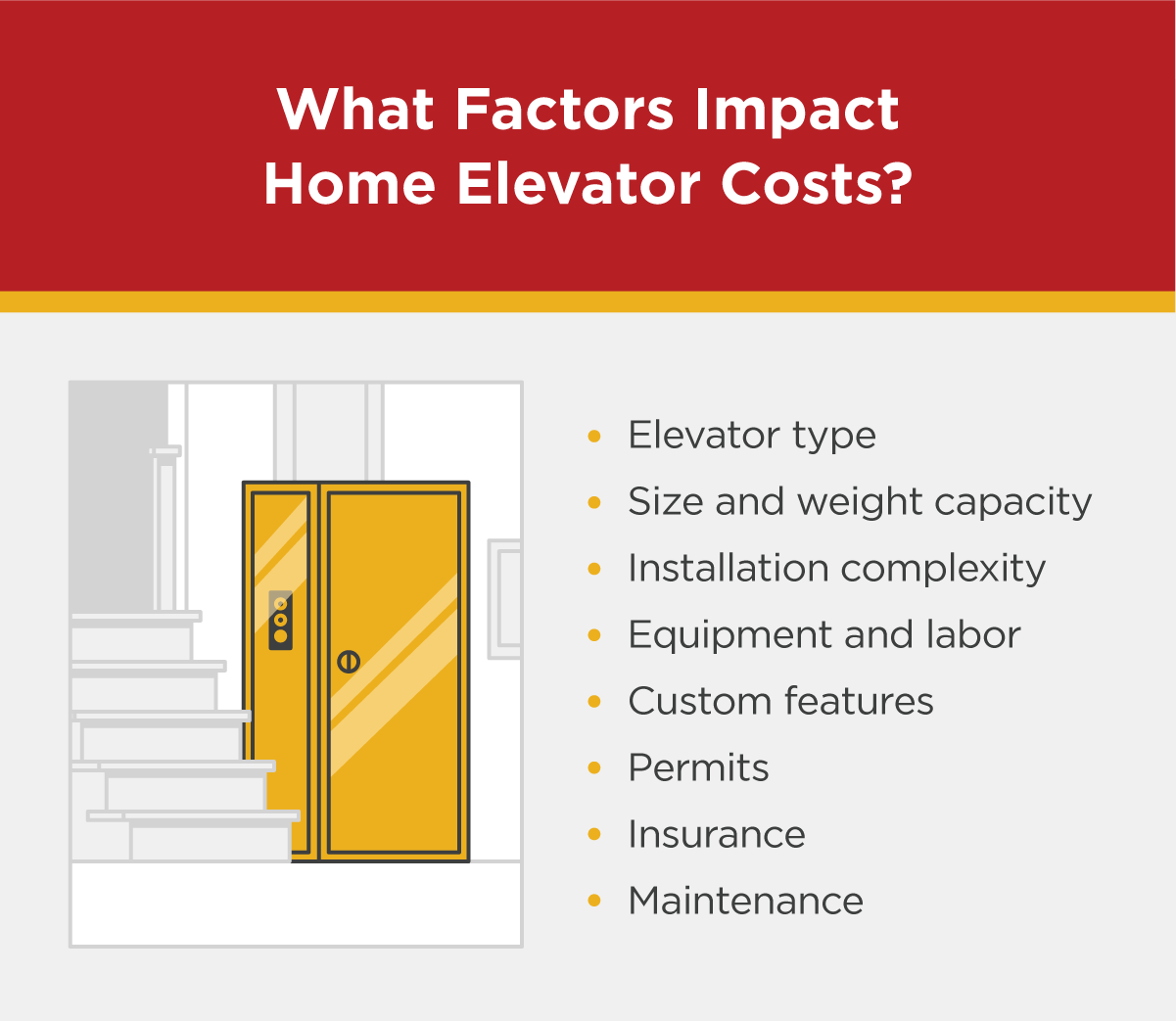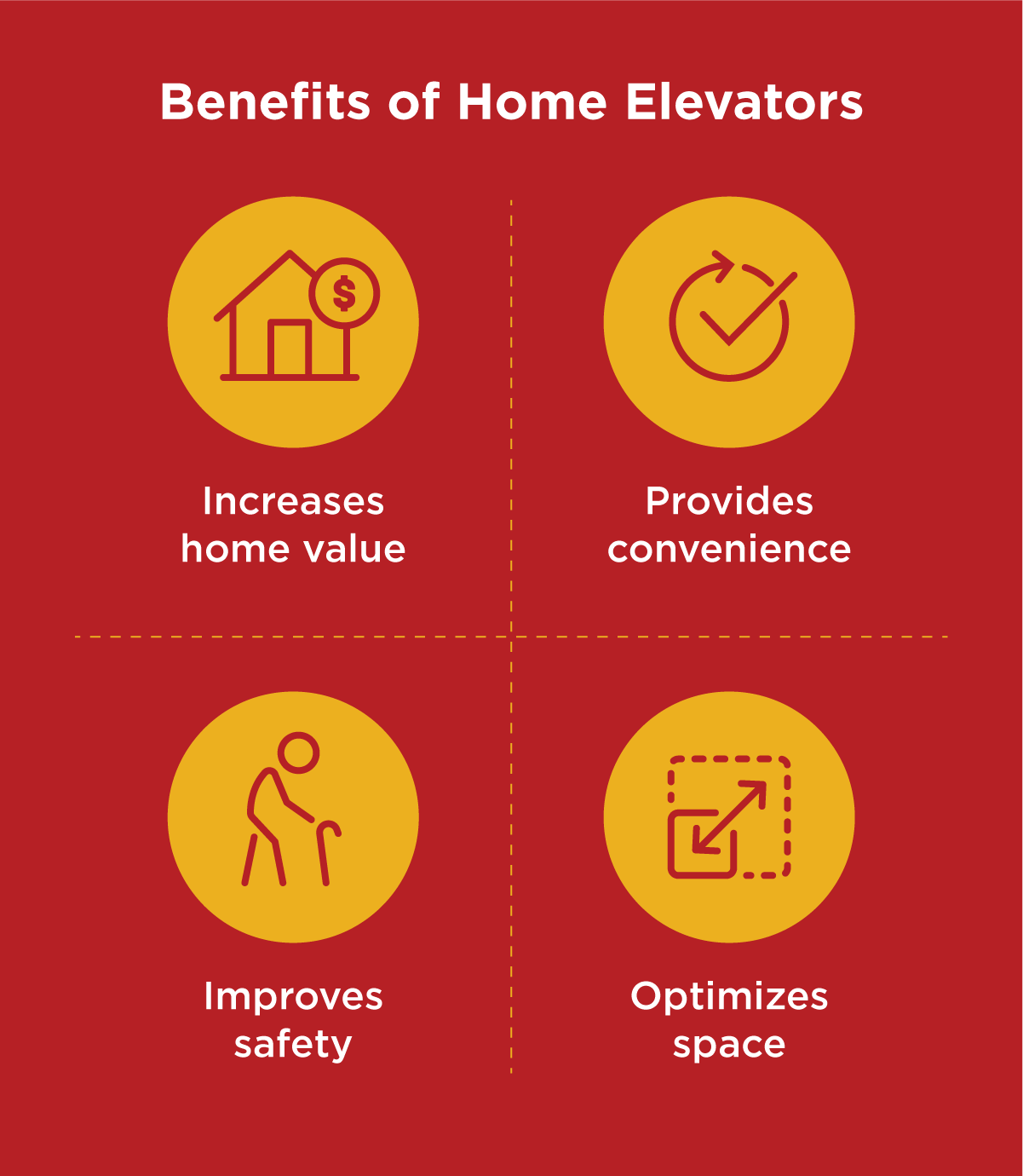How Much Does a Home Elevator Cost? [2024]
Home elevators have been rising in popularity throughout the 2020s, making homes more accessible and easy to navigate. The average home elevator cost in 2024 is $23,975, with $5,000 on the lower end and $55,000 on the higher end.
Home elevators come in many forms, including wheelchair lifts, pneumatic elevators, and vertical platforms. This guide will explore the factors that impact home elevator installation costs and connect you with home remodeling services in your area.
Average Home Elevator Cost Ranges in 2024
Home elevator installation projects can have drastically different prices depending on factors such as complexity and location. For instance, the average cost to build an elevator in Los Angeles County, California, is around $1.1 million, compared to the average price of $4,285 in Fulton County, Georgia.
The type of elevator also greatly influences the total price of a project:

Factors That Affect Home Elevator Costs
The type of elevator you choose, permitting fees, insurance premiums, and other variables affect the cost of your project. Learn which details impact home elevator installation costs to streamline the remodeling process.
Type of elevator
Different elevators require unique materials and components that can impact their installation costs. For example, cable-driven elevators are relatively simple and less expensive, while pneumatic elevators are generally more complex and costly.
Some of the most common types of home elevators include:
- Outdoor elevator: These elevators are installed outside a property and are common for homes where indoor space is limited. Outdoor elevators average around $6,000 and are best for those looking for more affordable options since they’re on the lower end of the price scale.
- Vertical platform lift: Vertical platform elevators can be installed both indoors and outdoors and offer a great alternative to traditional home elevators, averaging around $7,500. They’re smaller in design, more cost-effective, and offer those in wheelchairs or other mobility devices an easy way to get from one floor to another.
- Shaftless elevator: A shaftless elevator can only travel between two floors and is small in size, making it ideal for single individuals and homes with limited space. These elevators average around $20,000 or more depending on the level of customization.
- Cable-driven elevator: Cable-driven elevators are a traditional type of home elevator that uses a cable and motor to lift and lower the elevator car. They average around $25,000 and may require an additional $2,000 or more for cable replacements every few years.
- Geared traction elevator: This type of elevator is great for people looking for an energy-efficient home elevator option that can help save on energy bills. Geared traction elevators use gear motors, which are generally more efficient than direct drive motors, to move the elevator up and down. These elevators are on the pricier side, averaging around $31,500.
- Hydraulic elevator: These elevators use hydraulic pressure to raise and lower the elevator cab. They're a reliable and durable option, costing around $37,500 on average.
- Gearless traction elevator: Gearless traction elevators use direct drive motors to control the hoistway. They're an energy-efficient option and typically cost around $42,000.
- Pneumatic elevator: Pneumatic elevators use compressed air to maneuver the elevator car. They’re ideal for those who want a quieter system but require a larger budget—averaging around $47,500.
- Straight stair lift: Though they’re not technically elevators, straight chair lifts are a great way to help older adults or those with mobility limitations up and down a flight of stairs. You can expect to pay around $5,500 for a straight stair lift.
- Curved stair lift: Curved stair lifts are designed for non-straight stairways. Since they require more customization to match your stair design, they can cost upwards of $17,250.
Size and capacity
Elevator dimensions and weight capacity can greatly impact the cost of a home elevator. Elevators that travel across multiple floors naturally require more labor and components, so you could spend between $5,000 and $15,000 per story of the building you’re upgrading.
The size of an elevator car is another influential factor. A shaftless elevator normally fits one person and costs upwards of $20,000. Hydraulic elevators cost $25,000 to $50,000 but are ideal for supporting wheelchair users and older adults with limited mobility.
Equipment and labor
Equipment includes everything from pulley systems to mechanical rooms that keep an elevator running. Some essential pieces of equipment include:
- Car: This is the area where passengers board and ride the elevator. The cost can vary depending on the type of seat, car design, and special features you choose.
- Machine room: These rooms are the size of an average closet and house the motor, hydraulic tank, cables, and electrical components that raise, lower, and hold an elevator. Machine rooms are typically located in a basement or above the hoistway, but can differ based on the home’s design. Since machine rooms require additional labor, this could impact installation costs. Some home elevators, like a gearless traction elevator, don’t require a machine room.
- Sensors: These electrical devices are used for safety purposes to ensure the elevator operates safely. For example, door sensors prevent the elevator from working if the door isn’t properly closed, while speed sensors gauge an elevator’s speed and position. All home elevators include different types of sensors since they’re designed with safety as a priority, but costs may differ depending on the type of elevator model.
- Hoistway: The hoistway is the area where the elevator travels through your home. Aside from the cost of the elevator itself, the cost of hoistway installation can raise your costs even more. However, shaftless elevators don’t require a hoistway since they move along a guardrail.
Elevator installers and repairers can charge $49.24 per hour on average, though labor costs vary between cities and states. Speak with a local professional for more accurate estimates.
Installation complexity
Professionals must carefully assess the existing structure of a home before starting elevator construction. They may need to remove ceilings, walls, and portions of the floor to create space for an elevator.
Accessible home modifications such as stair lifts can vary in complexity. Straight stair lifts, which move along a straight rail, typically cost between $2,000 and $9,000. Curved stair lifts, on the other hand, range from $9,500 to $25,000.
Customization and features
Additional features like music speakers and glass panels can increase an elevator’s aesthetic and appeal. You can also incorporate smart home features such as a fingerprint reader or voice recognition software. Speak with local contractors to find the price of these add-ons in your neighborhood.
New construction vs. retrofitting
Building an elevator in a new home is typically easier than retrofitting an existing property.
- New construction: Home elevators can often be integrated into the design and construction of a new building more seamlessly and cost-effectively. Contractors can build hallways and support structures with an elevator’s size and dimensions in mind.
- Retrofitting: Adding a home elevator to an existing home can involve more significant structural modifications, potentially increasing costs. Contractors may have to demolish certain parts of a home and add supporting structures to build the elevator.
Permits and inspections
Mandatory permits and associated fees must be accounted for before contractors can break ground. Building permit costs vary by location; for example, a building permit in Missouri costs between $1,000 and $2,000 while a building permit in California ranges from $1,200 to $3,000.
- Local regulations: Obtain the necessary permits from local authorities and comply with building codes and regulations.
- Inspection fees: Expect to pay inspection fees to ensure the elevator meets safety standards. These fees range from $25 to $ 150 on average depending on your your location.
Maintenance
Regular maintenance is essential to keeping an elevator in working order. You’ll also want to have funds saved to purchase replacement parts if something breaks down.
- Regular inspections: Schedule regular inspections to identify and address potential issues.
- Maintenance contracts: Consider maintenance contracts for routine upkeep and emergency repairs. Contractors can charge between $75 and $100 per hour for maintenance jobs.
- Replacement parts: Be prepared to purchase replacement components over time. Parts like a new car panel could cost upwards of $1,000.
Insurance
Contact your insurance provider to determine if installing a home elevator will affect your homeowners insurance premium. If not, you’ll need to purchase liability insurance to cover injuries related to the elevator. Liability coverage typically costs around $150 to $300 per $1 million of coverage.

Benefits of Home Elevators
Home elevators offer many benefits for individuals with limited mobility or homeowners looking to turn an unused space into a functional feature.
Increases home value
Installing a home elevator can increase a home’s value by 10% to 25% if you choose to sell your property. Keep in mind that a home with a stair or wheelchair lift may appeal to homebuyers with limited mobility but may impact your resale value down the line since they aren’t typically a sought-after feature among homebuyers.
Provides convenience
Larger properties become much easier to navigate with elevators or lifts. This is especially true for mansions and homes with more than two stories. They can also provide an easier way to carry heavy items or transport groceries up and down floors.
Improves safety
People with unique mobility considerations may feel safer using an elevator to travel through their homes. These devices reduce the chances of someone slipping on a missed step or tiring themselves out.
Optimizes space
Homeowners can free up space in their properties by strategically remodeling certain areas. For example, a small home elevator can cost about $5,000, which mirrors the price of a curved staircase and may take up less space.

Home Elevator Installation Process
Installing a home elevator is a multistep process that can take several weeks depending on the project’s scope. The installation process generally is as follows:
- Consultation: This pivotal first step involves a discussion with the contractor and a breakdown of the project’s costs.
- Design and planning: You and the contractor will discuss a design plan based on your needs and your home’s layout. You may be able to use virtual reality software to gain a clear preview of the finished product.
- Site preparation: Professionals may have to remove walls and modify existing structures, which can cost anywhere from $500 to $15,000.
- Installation: The construction team transports all of the equipment and materials needed to build your elevator. They’ll also install electrical wiring as needed.
- Testing: The installers will stress test the newly built elevator to ensure safety.
- Inspection: In most states, you’ll be required to obtain a building permit before installing a home elevator. Once your elevator is installed, building inspectors from your county will review the elevator to ensure it’s compliant and safe to use. Contact your local county building office to discuss their fees for this inspection.
Contact Mr. HandymanⓇ To Improve Your Home's Accessibility
Now that you know more about home elevator costs, you can start transforming your home into a more accessible space. Contact Mr. Handyman to find quality safety and mobility services in your area.
We can install and replace grab bars, handrails, and lever door handles throughout your home. We can also widen doorways and install ramps for wheelchair users.
This article is intended for general informational purposes only and may not be applicable to every situation. You are responsible for determining the proper course of action for your home and property. Mr. Handyman is not responsible for any damages that occur as a result of this blog content or your actions. For the most accurate guidance, contact your local Mr. Handyman location for a comprehensive, on-site assessment.
Home Elevator Cost FAQs
Mr. Handyman has been helping homeowners repair, maintain, and enhance their spaces for over 25 years! We are the one-stop solution for everything on your to-do list. This includes answering your questions about home repairs, maintenance, and improvements. Here are answers to some of your most frequently asked questions about home elevators.
Are residential elevators worth it?
Residential elevators can greatly benefit homeowners with multistory properties and those with mobility limitations. Home elevators can also increase your home value by 10% to 25% if you sell it later.
How much does a home elevator cost compared to a stair lift?
Installing a home elevator is typically more expensive than building a stair lift. Labor costs, equipment and materials needed, permits, and insurance fees all increase the total price of the project.
What is the cheapest elevator to install?
Outdoor residential elevators tend to be the least expensive and least intrusive installation projects, as they’re installed to a home’s exterior. They cost an average of $6,000 to install, ranging from $2,000 on the low end to $10,000 on the higher end.
What are the cons of home elevators?
Installing a home elevator can present a few potential drawbacks:
- Price: Between labor, permitting fees, and overall installation costs, it can be expensive to build a home elevator. Homeowners will also have to set aside funds for elevator maintenance over time.
- Energy concerns: Elevators require considerable power to operate, and certain models can have a greater environmental impact.
- Sound: Home elevators can make a lot of noise when they’re active, which may take some time to get used to.
 Click to call
Click to call


